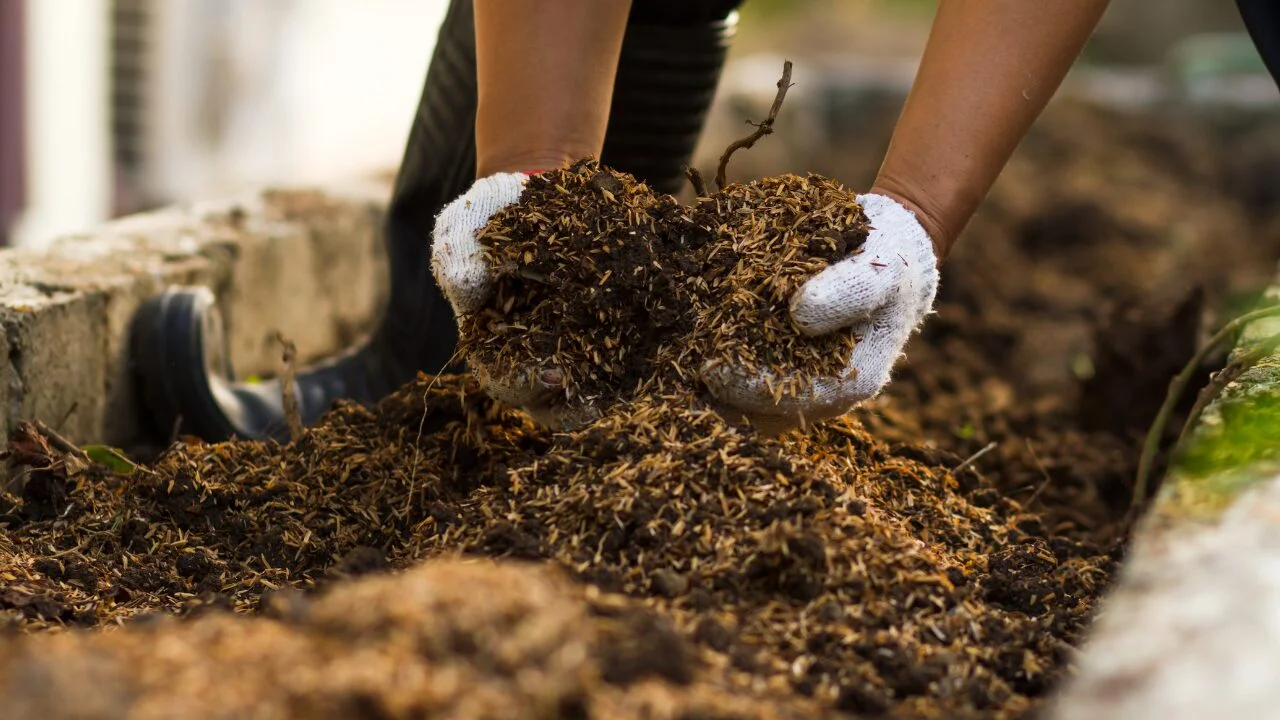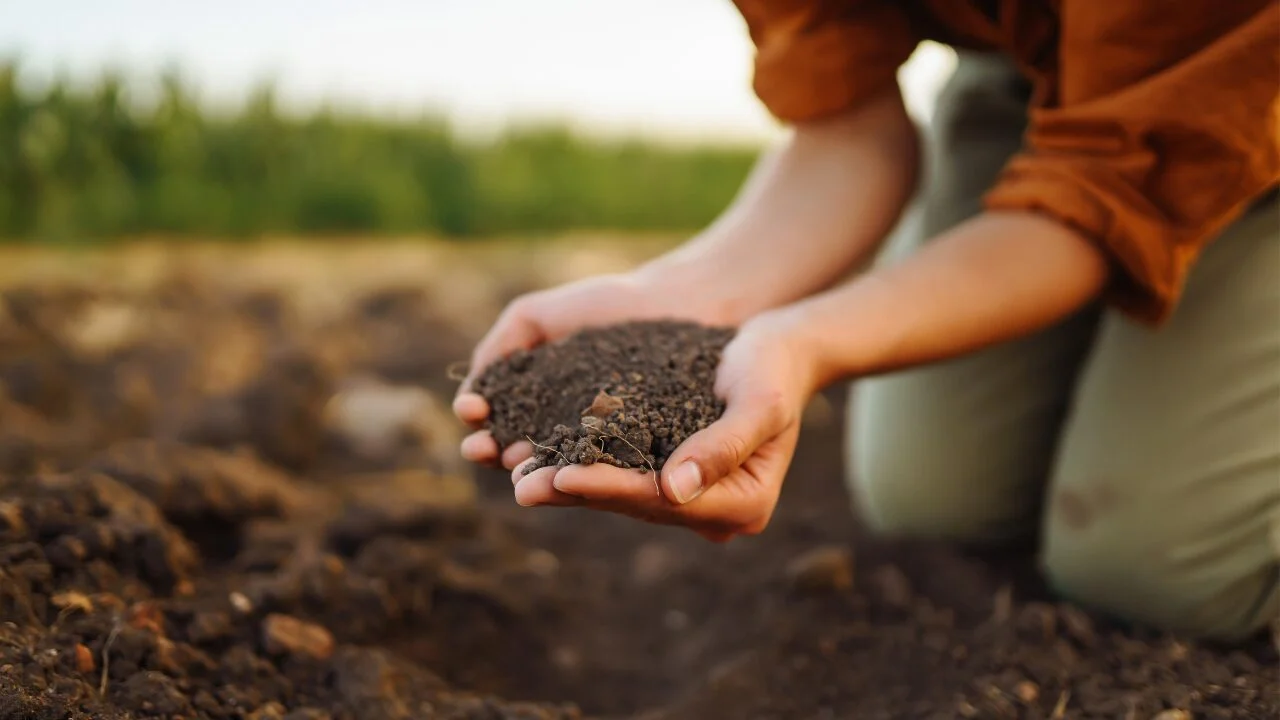Myth #1 – Composting Smells Bad
The Myth
One of the most common misconceptions about composting is that it produces strong, unpleasant odors. Many assume a compost bin will smell like rotting garbage, especially when food scraps are involved.
The Fact
Adequately managed compost doesn’t stink. A healthy compost pile emits an earthy, natural smell, similar to fresh soil. Foul odors typically arise when the compost is out of balance—too many “greens” (like food scraps) or not enough “browns” (like dry leaves) can create anaerobic conditions, which are responsible for foul smells.
What to Do Instead
Here are some simple steps to ensure your compost stays odor-free:
- Maintain a 2:1 Ratio of Browns to Greens:
Browns (carbon-rich materials) like dry leaves, shredded paper, and straw help absorb excess moisture and prevent odors. Balance these with greens (nitrogen-rich materials) like fruit peels, vegetable scraps, and coffee grounds.
- Turn the Pile Regularly
Aerating your compost by turning it every week or two introduces oxygen, essential for decomposition and prevents anaerobic conditions.
- Avoid Problematic Materials
Refrain from adding items like meat, dairy, or oily foods, which can attract pests and create unpleasant smells. Stick to plant-based food scraps and yard waste.
- Use a Lid or Cover
If you’re composting in a bin, use a lid or tarp to manage moisture and keep the pile tidy.
For a comprehensive guide to odor-free composting, check out EPA’s Composting Basics.
Myth #2 – Composting Is Only for People with Gardens
The Myth
Many people believe composting is exclusive to those with large backyards or gardens. Setting up a compost pile might seem impossible without a big outdoor space, leaving urban dwellers feeling left out of the composting movement.
The Fact
Urban composting is entirely feasible. Thanks to compact indoor bins, vermicomposting setups, and local compost collection programs, anyone—even apartment dwellers—can compost effectively. You don’t need a sprawling backyard to make an environmental impact; you need the right tools and approach.
What to Do Instead
- Use a Small Countertop Bin or Worm Composting Setup (Vermicomposting):
Compact bins designed for kitchen use are perfect for collecting food scraps. For an even more efficient system, try vermicomposting—a method where worms break down organic waste into nutrient-rich compost. Systems like the Urban Worm Bag are odor-free and easy to manage indoors.
- Take Advantage of Community Composting Services or Drop-Off Locations:
Many cities now offer curbside compost pickup or drop-off locations for food scraps. Organizations like Litterless maintain a directory of composting services across the U.S. Local farmers’ markets or community gardens may also accept organic waste for their compost systems.
- DIY Indoor Composting:
Use a bokashi bin, which ferments food waste and takes up minimal space, or an aerated indoor compost bin designed for small living areas. These systems are simple to set up and maintain, even in tight quarters.
Check out NRDC’s Urban Composting Guide for detailed tips on urban composting.
Myth #3 – Composting Is Too Complicated
The Myth
Many people shy away from composting because they think it’s a complicated process that requires precise measurements, constant monitoring, and a science degree to get it right. This misconception can make composting seem intimidating for beginners.
The Fact
While understanding some basics is helpful, composting is a forgiving process. It doesn’t have to be an exact science—minor adjustments along the way can keep your compost healthy and effective. Whether you want to keep it simple or dive into the details, composting can adapt to your level of experience and interest.
What to Do Instead
- Start with Easy-to-Compost Materials:
Focus on simple, plant-based scraps that break down quickly, such as:
- Fruit and vegetable peels.
- Coffee grounds and filters.
- Dry leaves or shredded paper.
As you start, avoid harder-to-manage items like greasy foods or dairy products.
- Monitor for Signs of Imbalance:
Composting is all about balance. If your pile starts to smell, you may have too many “greens” (nitrogen-rich items). Add more “browns” (carbon-rich materials) like dry leaves or cardboard to restore the balance. Conversely, if the pile is dry and slowly breaking down, mix in more greens and a bit of water.
- Follow a Beginner-Friendly Guide:
If you’re overwhelmed, start with a simple guide that breaks the process into manageable steps. For example, layer greens and browns in a 2:1 ratio, turn the pile occasionally and adjust moisture as needed.
Trustworthy Resource: Check out the USDA’s Composting Guide for a step-by-step beginner guide.

Myth #4 – Composting Attracts Pests
The Myth
One of the biggest concerns for would-be composters is the fear of inviting unwanted visitors like rodents, insects, or raccoons. This misconception often stems from improper composting practices, making your pile an unintended buffet for pests.
The Fact
Adequately managed compost doesn’t attract pests. Issues typically arise when food scraps are left exposed or when items like meat, dairy, or greasy foods are added to the pile. Your compost pile can remain pest-free and productive with the proper setup and practices.
What to Do Instead
- Use a Secure, Lidded Compost Bin or Tumbler:
Invest in a compost bin with a tight-fitting lid or use a tumbler design that prevents pests from accessing the pile. These containers are especially useful for urban and suburban areas where wildlife might be a concern.
- Avoid Adding Problematic Items:
Refrain from adding meat, dairy, oily foods, or any other scraps that tend to attract pests. Stick to plant-based materials like fruit peels, vegetable scraps, coffee grounds, and dry leaves.
- Cover Food Scraps with Browns:
Always layer your greens (food scraps) with browns (dry leaves, shredded newspaper, or cardboard). This creates a barrier that minimizes odors and makes the pile less appealing to pests.
- Regular Maintenance:
Turn your compost regularly to aerate it and maintain the proper balance of materials. A well-maintained pile decomposes quickly, leaving little opportunity for pests to take an interest.
Trustworthy Resource: For more tips on pest-free composting, visit Rodale Institute’s Composting Tips.
Myth #5 – Composting Takes Too Long
The Myth:
Many people hesitate to start composting because they think it takes forever to see results. The idea of waiting months for finished compost can feel discouraging, especially for beginners looking for quicker rewards.
The Fact
While it’s true that full composting can take several weeks to months, depending on conditions, there are ways to speed up the process significantly. You can produce nutrient-rich compost much faster than expected with a few simple adjustments.
What to Do Instead
- Chop or Shred Materials Into Smaller Pieces:
Smaller particles break down faster, giving microorganisms more surface area to work on. For example, cut fruit peels, break down cardboard, and shred dry leaves before adding them to the pile.
- Turn Your Pile Frequently:
Regularly turning your compost pile (once every 1–2 weeks) introduces oxygen, accelerating microbial activity and preventing the pile from becoming anaerobic. Aeration is key to faster decomposition.
- Consider Using Compost Accelerators or Bokashi Systems:
- Compost Accelerators: These products boost nitrogen and beneficial microbes to your pile, kickstarting decomposition.
- Bokashi Systems: A fermentation method that quickly pre-processes organic waste, bokashi composting is perfect for those seeking faster results, particularly in urban settings.
- Maintain Optimal Conditions:
- Keep your compost pile moist like a damp sponge to support microbial activity.
- Balance your greens (nitrogen-rich) and browns (carbon-rich) for efficient breakdown.
Trustworthy Resource: For more tips on speeding up the composting process, check out the Master Gardener Programs’ Guide.



